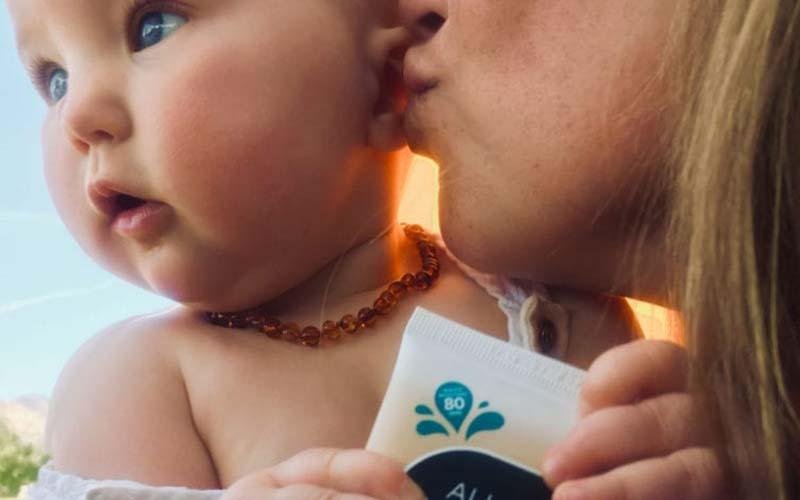FREE 🇺🇸 SHIPPING ON ORDERS $75+
FREE 🇺🇸 SHIPPING ON ORDERS $75+
Add description, images, menus and links to your mega menu
A column with no settings can be used as a spacer
Link to your collections, sales and even external links
Add up to five columns
Add description, images, menus and links to your mega menu
A column with no settings can be used as a spacer
Link to your collections, sales and even external links
Add up to five columns
Reef & Body Friendly Sunscreen
June 10, 2021

REEF & BODY FRIENDLY SUNSCREEN.
As told by our friends from All Good.
There are loads of toxic chemicals in conventional sunscreen that harm coral reefs in many different ways. First, harmful chemicals in conventional sunscreen enter the ocean when vacationers, swimmers, surfers, etc. use a toxic sunscreen on their body and get in the ocean. Even if you don’t go directly in the ocean, sunscreen lotion will eventually be washed off your body in the shower and end up back to the ocean. These chemicals are very tenacious.
And if you thought you were very different than coral reefs, think again. After you lather yourself head to toe, your skin begins to absorb chemicals from sunscreen. These chemicals can be measured in the body through blood, breast milk, and urine samples. Even the FDA has found that some of these toxic ingredients enter the bloodstream at levels far beyond what the recommended FDA-established threshold. Yet another reason mineral sunscreens are the better choice for you and for the coral reefs.
How do I know if a sunscreen is “reef friendly”?
When you’re shopping for reef-friendly sunscreen, there are a few main ingredients to avoid. Chemicals such as oxybenzone and octinoxate are harmful to coral reefs. These chemicals can cause sunscreen-induced coral bleaching. When shopping for reef-friendly sunscreen, look for a “reef-friendly” label or the absence of oxybenzone and octinoxate.
Sunscreen Ingredients That Are Harmful To Reefs
The compounds in these ingredients, preservatives, and additives are toxic to humans and coral reefs. If any one of these ingredients is listed in a sunscreen, it is NOT considered reef safe, reef friendly, or – you guessed it – safe for you.
1. “The Awful Eight”
- Oxybenzone
- Octinoxate
- Octocrylene
- PABA (Aminobenzoic Acid)
- Enzacamene
- Octisalate
- Homosalate
- Avobenzone
2. Preservatives & Additives
- Methyl Paraben
- Ethyl Paraben
- Propyl Paraben
- Butyl Paraben
- Benzyl Paraben
- Phthalates
- Triclosan
- Microbeads (plastic)
- Phenoxyethanol
Oxybenzone deserves a special call out for its particularly horrible damage on coral reefs and humans; you can learn more about public enemy number one here.
Reef-friendly Ingredients
The good list is short and sweet:
-
Non-nano Zinc oxide
-
Non-nano Titanium dioxide

Look for unscented, oxybenzone-free, mineral-based sunscreens that use raw elements instead of synthetic ones and exclude the “unsafe” ingredients and preservatives that disrupt human hormone function or bleach coral. The only way to really know is to read the labels and look for the toxic ingredients.
All Good Sunscreens offer the same broad spectrum protection (from both UVA and UVB rays) as conventional sunscreens, without relying on toxic ingredients. We do this by avoiding the “Awful Eight” and using these two main ingredients instead:
Zinc Oxide is derived from the mineral zinc. It’s able to block UV (especially UVA) rays just as effectively as any of the Awful Eight. Because it’s mineral-based, it won’t seep into your skin to risk your health, is less harmful to coral, and is not known to cause coral bleaching. With that said, avoid sunscreens with zinc oxide that are labeled as “clear zinc” or “transparent”. They’re likely to use zinc oxide nanoparticles (very very small-size particles of zinc oxide) to achieve this transparency, which scientists have found toxic to sea creatures and coral. So look for non-nano zinc sunscreens.
Titanium Oxide, like zinc oxide, sunscreens that contain titanium dioxide are mineral-based. Titanium dioxide is a great alternative to oxybenzone and octinoxate. It provides effective protection against UV rays (especially UVB). Sunscreens created with both zinc oxide and titanium dioxide can offer broad spectrum protection against both UVA and UVB rays. However, make sure that the titanium dioxide in your sunscreen is non-nano. Like zinc oxide, titanium dioxide nanoparticles can clog coral when ingested and lead to coral bleaching.
We carry a broad selection of All Good Sunscreens for kids and big kids alike from 30 SPF to 50 SPF in addition to natural deodorants, muscle soothers, skin moisturizer and balms. They are definitely worth your hard earned dollars. And because they give back 1% to the Planet, and so do we, your purchase does double the good.
Our deep thanks to All Good for the ingenuity and thoughtfulness they put into all of their products. And appreciation for posting great information on their website for little businesses like What's Good to consume and share. Photo and most of the words are theirs, not ours. xo
THANKS FOR READING. LEARN ABOUT OUR SALES SOONER BY SIGNING UP TO RECEIVE OUR E-NEWSLETTER. IN THE MEANTIME, HERE YOU GO:
SAVE 20% ON ALL, ALL GOOD PRODUCTS. EXPIRES JUNE 15 AT 11:59PM EST. ENTER THIS CODE AT CHECKOUT: ALLGOOD20
Leave a comment

Good News
If any email is worthy of your inbox, it's this. Our goal is 1–2x per month. You'll get helpful & inspiring eco info, plus subscriber-only discounts.
Welcome to What's Good
Here's your $10 coupon
COPY THIS CODE TO USE IN CHECKOUT
